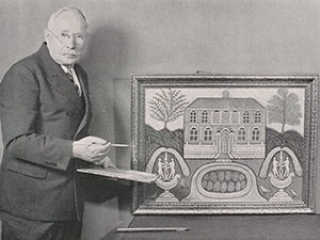Born 1872, Western Poland
Died 1946, Brooklyn, New York
Before he began to paint in 1937, Morris Hirshfield owned a business manufacturing women’s coats and suits as well as an extremely successful company that produced bedroom slippers. He showed his first canvases to John I. H. Baur, a curator of American painting and sculpture at the Brooklyn Museum, and soon attracted the attention of gallerist Sidney Janis, himself a former shirt manufacturer. Janis’s interest in self-taught artists began with his purchase of Henri Rousseau’s The Dream (1910) in 1934, and he included Hirshfield in a show he arranged for MoMA’s “member’s room” in 1939, Contemporary Unknown American Painters, as well as in his book They Taught Themselves: American Primitive Painters of the 20th Century in 1942. Also in 1942 Hirshfield participated in the First Papers of Surrealism, the first official surrealist exhibition in America, and modernist critic Clement Greenberg backhandedly referred to the painter as one of America’s best. In 1943 Hirshfield was the first self-taught artist to have a comprehensive retrospective at MoMA. The negative press received by the show became one of the factors precipitating Alfred Barr’s demotion as director.
Hirshfield worked laboriously to cover every inch of his canvases with minutely rendered patterns that created pulsing compositions, typically featuring animals or women. In an approach that reflected his former occupation, he transferred a basic, linear design to canvas, filling it in with textures reminiscent of tweeds or knits and lavishing attention on the depiction of draperies, upholstery, and clothing. This ornamental sensibility recalls the intricate filigree of traditional Jewish paper cutting and of Islamic decorative arts. Hirshfield repeated motifs such as flowers with heraldic rigor and often employed symmetry and theatrical devices such as curtains, lending his paintings a medieval mood reminiscent of manuscript illumination.
Barr admired Hirshfield’s Tiger as one of the most “unforgettable” animal pictures in modern art. The vivid, agitated patterns—with the striated sky streaming outward from the tiger’s banded coat atop densely packed vegetation—and the creature’s alert gaze imbue this work with an intense psychological charge. The surrealists appreciated the unusual eroticism of works such as Girl with Pigeons. In this peculiar canvas, the female figure appears rotated and floating against a sofa rendered in distorted perspective and framed by stylized fronds and exquisitely ornamented birds. The composition is an evident riposte to Rousseau’s The Dream, which Hirshfield infamously found wanting.
Jenevive Nykolak
Janis, Sidney. They Taught Themselves: American Primitive Painters of the 20th Century. Foreword by Alfred H. Barr Jr. New York: The Dial Press, 1942.
